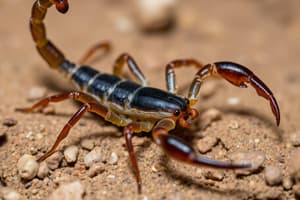Podcast
Questions and Answers
What is the distinguishing feature of arthropods?
What is the distinguishing feature of arthropods?
- Presence of a segmented body
- Jointed appendages
- Skeletal covering composed of chitin (correct)
- Soft exoskeleton
Approximately what percentage of all known animal species belong to the phylum Arthropoda?
Approximately what percentage of all known animal species belong to the phylum Arthropoda?
- 56%
- 97%
- 84% (correct)
- 24%
Which subphylum of Arthropoda includes insects and springtails?
Which subphylum of Arthropoda includes insects and springtails?
- Hexapoda (correct)
- Chelicerata
- Myriapoda
- Crustacea
What is the relationship between arthropods and annelids according to molecular phylogenetic analyses?
What is the relationship between arthropods and annelids according to molecular phylogenetic analyses?
Which of the following is NOT a member of the superphylum containing arthropods?
Which of the following is NOT a member of the superphylum containing arthropods?
What substance is responsible for the jointed skeletal covering in arthropods?
What substance is responsible for the jointed skeletal covering in arthropods?
What is the term used to refer to arthropods possessing only single-branched appendages, including insects, centipedes, and millipedes?
What is the term used to refer to arthropods possessing only single-branched appendages, including insects, centipedes, and millipedes?
Which extinct subphylum of Arthropoda is made up of trilobites, the dominant arthropods in the early Paleozoic seas?
Which extinct subphylum of Arthropoda is made up of trilobites, the dominant arthropods in the early Paleozoic seas?
What type of muscle predominates in arthropods, enabling faster contraction rates and facilitating flight in many insects?
What type of muscle predominates in arthropods, enabling faster contraction rates and facilitating flight in many insects?
Which type of development do most arthropods exhibit, where the immature form is a larva that differs significantly from the parent?
Which type of development do most arthropods exhibit, where the immature form is a larva that differs significantly from the parent?
What significant feature distinguishes chelicerates, such as spiders and mites, from other arthropods?
What significant feature distinguishes chelicerates, such as spiders and mites, from other arthropods?
What prominent nerve structure do arthropods possess in their nervous system, branching into smaller nerve fibers that innervate the appendages?
What prominent nerve structure do arthropods possess in their nervous system, branching into smaller nerve fibers that innervate the appendages?
Study Notes
Phylum Arthropoda: The Widest Range of Animals
Introduction
The phylum Arthropoda is the largest phylum in the animal kingdom, containing a wide variety of animals with hard exoskeletons and jointed appendages. This phylum includes familiar forms such as lobsters, crabs, spiders, mites, insects, centipedes, and millipedes. Approximately 84% of all known species of animals belong to this phylum. The distinguishing feature of arthropods is the presence of a jointed skeletal covering composed of chitin, which is secreted by the underlying epidermis.
Evolution and Relationships
Arthropods are invertebrates and are classified in the phylum Arthropoda. They are closely related to the annelids, which have a segmented body. However, molecular phylogenetic analyses have shown that arthropods are members of a superphylum which contains nematodes, priapulids, and tardigrades but excludes annelids. This suggests that segmentation in arthropods and annelids either evolved convergently or has been inherited from a much older ancestor such as the non-arthropod members of the Ecdysozoa.
Classification and Subphyla
The phylum Arthropoda is commonly divided into four subphyla of extant forms: Chelicerata (arachnids), Crustacea (crustaceans), Hexapoda (insects and springtails), and Myriapoda (millipedes and centipedes). Some zoologists believe that arthropods possessing only single-branched appendages, particularly the insects, centipedes, and millipedes, evolved from a separate ancestor and therefore group them within a separate phylum—the Uniramia, or Atelocerata. In addition, the phylum Arthropoda contains the extinct subphylum Trilobitomorpha, which is made up of the trilobites, the dominant arthropods in the early Paleozoic seas.
Habitats and Adaptations
Arthropods are found in every habitat on Earth and show a great variety of adaptations. Some live in aquatic environments, and others reside in terrestrial ones. Some groups are even adapted for flight. The body is usually segmented, and the segments bear paired jointed appendages, from which the name 'arthropod' ('jointed feet') is derived. Arthropods have a complete digestive system and a true coelom. They have a nervous system with a large ventral nerve cord that branches into many smaller nerve fibers that innervate the various appendages.
Musculature
Arthropod muscles are primarily striated, which allows for faster contraction rates and has enabled the development of flight in many insects. Striated muscle is not as efficient as smooth muscle for sustained activities, but it is better suited for rapid movements and is used in the development of complex behaviors such as flight.
Life Cycles and Reproduction
Most arthropods have indirect development, which means that the immature form is a larva that appears very different from the parent and undergoes a process of transformation. For example, insects undergo a caterpillar to butterfly transformation, while crustaceans and chelicerates have a more complex metamorphosis. Chelicerates, such as spiders and mites, lack antennae and have a different method of food processing than other arthropods.
Conclusion
The phylum Arthropoda is a diverse and successful group of animals with a wide range of habitats and adaptations. Its members play a crucial role in various ecosystems and have evolved to occupy almost every conceivable niche. The study of arthropods continues to provide insights into the evolution of complex behaviors and life cycles.
Studying That Suits You
Use AI to generate personalized quizzes and flashcards to suit your learning preferences.
Description
Explore the characteristics, evolution, classification, habitats, musculature, and life cycles of the diverse group of animals in the phylum Arthropoda. Learn about their jointed appendages, segmented bodies, and significant role in various ecosystems.



